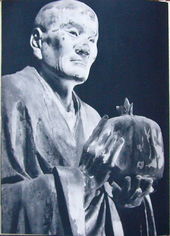
Back Асанга Bulgarian অসঙ্গ Bengali/Bangla རྗེ་བཙུན་ཐོགས་མེད། Tibetan Asanga German Asango Esperanto Asanga Spanish Asanga Basque آسانگا Persian Asanga French असंग Hindi

Asaṅga (Sanskrit: असंग, Tibetan: ཐོགས་མེད།, Wylie: thogs med, traditional Chinese: 無著; ; pinyin: Wúzhuó; Romaji: Mujaku) (fl. 4th century C.E.) was one of the most important spiritual figures of Mahayana Buddhism and the founder of the Yogachara school.[1][2][3] Traditionally, he and his half-brother Vasubandhu are regarded as the major classical Indian Sanskrit exponents of Mahayana Abhidharma, Vijñanavada (awareness only; also called Vijñaptivāda, the doctrine of ideas or percepts, and Vijñaptimātratā-vāda, the doctrine of 'mere representation) thought and Mahayana teachings on the bodhisattva path. He is also traditionally considered as one of the seventeen Nalanda masters who taught at the monastery which is located in modern-day Bihar.[4]
- ^ Asanga at the Encyclopædia Britannica. "Asaṅga, (flourished 5th century AD, b. Puruṣapura, India), influential Buddhist philosopher who established the Yogācāra (“Practice of Yogā”) school of idealism."
- ^ Engle, Artemus (translator), Asanga, The Bodhisattva Path to Unsurpassed Enlightenment: A Complete Translation of the Bodhisattvabhumi, Shambhala Publications, 2016, Translator's introduction.
- ^ Rahula, Walpola; Boin-Webb, Sara (translators); Asanga, Abhidharmasamuccaya: The Compendium of the Higher Teaching, Jain Publishing Company, 2015, p. xiii.
- ^ Niraj Kumar; George van Driem; Phunchok Stobdan (18 November 2020). Himalayan Bridge. KW. pp. 253–255. ISBN 978-1-00-021549-6.